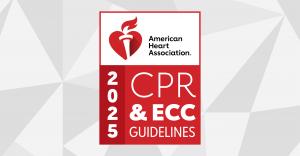Updated CPR guidelines tackle choking response, opioid-related emergencies and a revised Chain of Survival
American Heart Association Guidelines
DALLAS, TX, UNITED STATES, October 22, 2025 /EINPresswire.com/ -- The “2025 American Heart Association Guidelines for Cardiopulmonary Resuscitation (CPR) and Emergency Cardiovascular Care (ECC),” published today in the Association’s flagship journal, Circulation, marks the first full revision of lifesaving resuscitation guidance since 2020. Among the updates are expanded recommendations for managing choking and suspected opioid overdose, in addition to other lifesaving interventions.Each year, approximately 350,000 people in the U.S. experience an out-of-hospital cardiac arrest – when the heart suddenly stops beating – which results in death 90% of the time, according to the Association’s statistics.[1] The 2025 CPR guidelines provide an extensive review of the latest science, translating it into clear, lifesaving recommendations that empower people to act when every second counts.
Out-of-hospital cardiac arrests caused by respiratory emergencies or asphyxia occur in more than 9% of adults and 39% of children in the U.S.[2] New guidance on choking recommends alternating five back blows followed by five abdominal thrusts for conscious children and adults, until the foreign object is expelled or the person becomes unresponsive. Choking guidance for adults was not included in the previous guidelines, and earlier guidance for children called for performing abdominal thrusts only. For infants, rescuers should alternate between five back blows and five chest thrusts using the heel of one hand, until the foreign object is expelled or the infant becomes unresponsive. Abdominal thrusts are not recommended for infants, due to the risk of injury.
The guidelines also provide updated recommendations for treating people experiencing a suspected opioid overdose, which is the cause of 80% of all drug overdose deaths worldwide.[3] According to the World Health Organization (WHO), opioid use can lead to death because opioids affect the part of the brain that regulates breathing. Signs of an opioid overdose include:
Slow, shallow or no breathing
Choking or gurgling sounds
Drowsiness or loss of consciousness
Small, constricted pupils
Blue or grey coloring of the skin, lips or nail beds
For the first time, the guidelines provide public access instruction on when to use naloxone, a medication used to reverse or reduce the effects of opioids.
“The American Heart Association’s 2025 CPR guidelines represent gold standard science. It reflects a rigorous examination of the most up-to-date evidence that guides how resuscitation is provided for critically ill patients,” said Ashish Panchal, M.D., Ph.D., volunteer chair of the American Heart Association Emergency Cardiovascular Care Science Committee, physician and professor of emergency medicine at The Ohio State University. “As the science continues to evolve, it’s important that we continue to review new research specific to the scientific questions considered of greatest clinical significance that affect how we deliver life-saving care.”
Together with the American Academy of Pediatrics, the Association co-developed the pediatric and neonatal guidelines that help protect the youngest and most vulnerable lives. These chapters were co-led by volunteer experts from both organizations, with writing groups evenly balanced between their members, resulting in a unified set of recommendations that reflect the shared expertise, dedication and vision of both organizations.
Alongside major changes to choking recommendations for infants, the neonatal guidelines provide further direction for treating newborns. For most term and preterm infants not needing immediate resuscitation, delaying umbilical cord clamping for at least 60 seconds – up from the previously recommended 30 seconds – has been shown to improve a newborn’s blood health and iron levels.
“We’re proud that these guidelines will be jointly published in the American Heart Association journal Circulation and the American Academy of Pediatrics journal Pediatrics. This action underscores our joint commitment to advancing pediatric and neonatal resuscitation — together,” said Javier Lasa, MD, FAHA, FAAP, American Heart Association and American Academy of Pediatrics volunteer and co-chair of the 2025 Pediatric Advanced Life Support Writing Group and associate professor in critical care and cardiology at Children’s Health in Dallas.
Further updates offer suggestions for increasing lay rescuer intervention in a cardiac emergency, noting that only approximately 41% of adults experiencing cardiac arrest outside of the hospital receive CPR before emergency medical services arrive.[4] Early CPR could double or triple a person’s chance of survival. New recommendations include... see full release here: https://newsroom.heart.org/news/updated-cpr-guidelines-tackle-choking-response-opioid-related-emergencies-and-a-revised-chain-of-survival
Monica Sales
American Heart Association
+19368280833 ext.
email us here
Legal Disclaimer:
EIN Presswire provides this news content "as is" without warranty of any kind. We do not accept any responsibility or liability for the accuracy, content, images, videos, licenses, completeness, legality, or reliability of the information contained in this article. If you have any complaints or copyright issues related to this article, kindly contact the author above.

